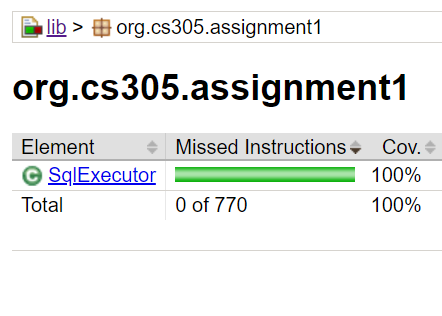Submitter name: Tanuj Maheshwari
Roll No.: 2019CSB1125
Course: CS305 (Software Engineering)
Java based library for executing SQL queries for CRUD operations against an RDBMS.
This is a Java library that can be used for executing basic SQL queries, i.e. SELECT, INSERT, DELETE and UPDATE (CRUD operations) against an RDMS such as MySQL, PostgreSQL, etc.
The SQL queries to be processed are grabbed from an XML file with a specific format, an example of which can be found here. The queries can be complete on their own, or could be dynamically populated from user defined parameters at run time. The results from the SQL queries are used to populate plain old java objects (POJOs).
First, the XML file is loaded from the path provided. The desired SQL query is then parsed from the XML file using the unique id parameter of each <sql> tag. The subsequent query received is termed as "raw query".
Next, the raw query parsed from the XML file is populated (i.e. the ${...} is replaced with the appropriate value(s)) from the parameter passed as an argument to the called function.
The SQL command then created, referred to as "populated query" is then executed through the database connection object
The result of SQL query is then either returned to the user (in terms of number of rows affected in case of INSERT, UPDATE and DELETE commands), or used to populate a Java object (in case of SELECT command).
The library implements 5 functions that can be used to achieve the desired results. These are :-
selectOne()Picks the record received from the SELECT query and returns an object populated with it.selectMany()Returns aList<>of objects populated with all the records from SELECT query.insert()Runs an INSERT query and returns number of rows affected.update()Runs an UPDATE query and returns number of rows affected.delete()Runs an DELETE query and returns number of rows affected.
NOTE -
selectOne()returnsnullif the query selects 0 records, and throws an exception if the query selects more than one record.
IMPORTANT - The POJOs to be populated using
selectOne()andselectMany()must have default getters and setters
To use these functions, user needs to define an object of class org.cs305.assignment1.SqlExecutor, and call these functions accordingly.
The constructor for SqlExecutor takes two commands :-
pathToXMLFileis aStringwhich contains the absolute path to the XML file where SQL commands are stored.dbConnectionis ajava.sql.Connectionobject which contains the database connection object.
The following types are supported to be provided as queryParam/paramType, with their corresponding ${...} values to be specified in XML:-
- null -
${...}(i.e. no ${} should be present in the query) - Primitive types & their Wrappers - ${value}
- String - ${value}
- Arrays (of type 2, 3) - ${value}
- Collections (of type 2, 3) - ${value}
- Objects (with fields of type 2 to 5) - ${field_name}
- Date - ${value}
- Arrays/Collections of objects (with overridden toString() method) - ${value}
- Generic objects (with fields of type 2 to 5, or with overridden toString() methods) - ${field_name}
For fields 7, 8 and 9, the object types must have overridden toString() methods, like
@Override
public String toString() {
//return the string format for this object
//which will replace ${prop} in the raw SQL query
}
The program can raise several exceptions, and all will be of the type java.lang.RuntimeException, some of which are :-
- Passing a
nullobject when paramType is not specified as "null" - paramType and
queryParamclass mismatch (note that paramType must contain the Fully Qualified Name for the class) - No query id match found
- No field found in
queryParamcorresponding to "${prop}" name - No field found in POJO corresponding to column label
- Failure to cast from SQL query result type to POJO field type
- SQL query corresponding to
selectOne()returning more than one record - Exception(s) raised in making database connection statement
- Exception(s) raised while executing SQL commands
The library is built in java, using gradle, and hence JDK and gradle must be installed on the system.
Also, the built-in tests run on the MySQL Sakila database, hence to run those, MySQL is needed and Sakila database must be loaded.
Clone the repository from GitHub to get the code, and then change branch to assignment_1 by executing the following commands :-
git clone https://github.com/tanuj-maheshwari/cs305_2022.git
git checkout assignment_1
To run unit tests provided within the implementation,
-
Open SqlExecutorTest
-
Change line 31 as follows :-
dbConnection = DriverManager.getConnection("jdbc:mysql://localhost:3306/sakila","<root username>","<password>");Change 3306 to MySQL's port number (default is 3306)
-
Remove line 32 if changes are to be committed in the database
-
Change line 33 as follows :-
sqlExecutor = new SqlExecutor("<Absolute path to XML file>", dbConnection);
-
-
Run the following command from the project directory (i.e. the directory where the repository is cloned) :-
./gradlew testNOTE - If running on Windows, replace ./gradlew with gradlew
Detailed code coverage report can be generated using JaCoCo. To generate the report, run :-
./gradlew jacocoTestReport
NOTE - If running on Windows, replace ./gradlew with gradlew
The test report generated is located at lib/build/reports/jacoco/test/html/index.html
To build a JAR so that the library could be used in any project, run :-
./gradlew build
NOTE - If running on Windows, replace ./gradlew with gradlew
The JAR file built will be located at lib/build/libs/lib.jar
The unit tests provided cover 100% percent of the code. Below is a snapshot of the code coverage report generated by IntelliJ and JaCoCo.


